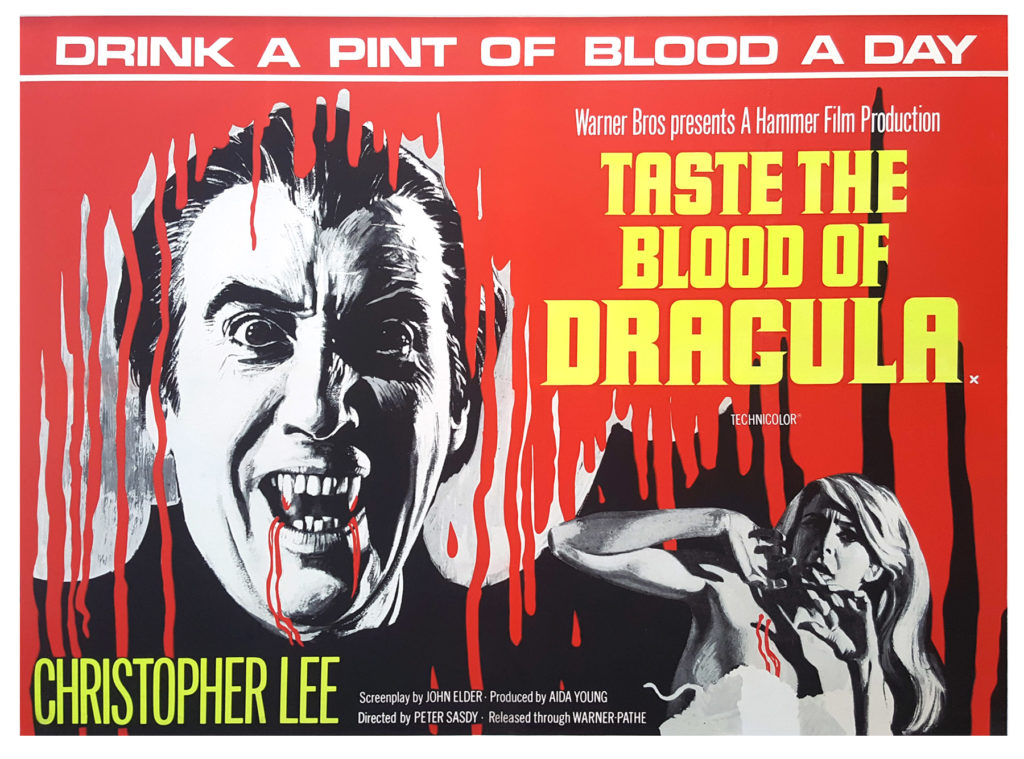What a title. Taste the Blood of Dracula. That’s a pretty good start for today’s horror film, before a single frame even goes by. From 1970, Taste the Blood of Dracula was written by Anthony Hinds, directed by Peter Sasdy, and features Christopher Lee returning to play Dracula.
In the previous film, Dracula Has Risen from the Grave, the evil count was killed. No spoilers there, really. Every Hammer Dracula film, in which Dracula actually makes an appearance, ends with his death. Then in the next installment the filmmakers use some creative, or not so creative, means to resurrect him.
We’re all familiar with the broad strokes of movie vampirism. Vampires can be killed by direct sunlight, a wooden stake piercing the heart, or removing the head. There are a couple of other methods that filmmakers have used, but those are the big ones. Resurrection, on the other hand, doesn’t have any established rules. Just as long as Dracula comes back, how it’s done has been treated as an afterthought in a couple of these flicks. Not here, though.
While traveling near Castle Dracula, an English shop owner named Weller (Roy Kinnear) is tossed from his carriage and ends up wandering through the woods. A scream pierces the night air, and Weller seeks it out. He becomes a hidden witness to the death scene from the previous film. After Dracula finishes his throes, Weller emerges from his hiding place and collects Dracula’s blood, now turned to powder by some supernatural force.
After this, the scene shifts to London, and the movie briefly becomes Pride and Prejudice. But that doesn’t last long. The love stories of the young and pretty pass by like some rote character development, and that’s a good thing. The more important characters are three older gentlemen — William Hargood (Geoffrey Keen), Samuel Paxton (Peter Sallis), and Jonathan Secker (John Carson). On the surface, these three men are the very picture of upper crust stuffiness. Hargood controls  his daughter, Alice (Linda Hayden), like a tyrant, admonishing her as a trollop when she so much as smiles at her suitor, Paul Paxton (Anthony Higgins), son of Samuel. But Hargood is the biggest of hypocrites.
his daughter, Alice (Linda Hayden), like a tyrant, admonishing her as a trollop when she so much as smiles at her suitor, Paul Paxton (Anthony Higgins), son of Samuel. But Hargood is the biggest of hypocrites.
While Hargood bars Alice from leaving the house and calls her a harlot, he steps out with Paxton and Secker for a night of debauchery in a brothel.
The brothel scene alone makes this film worth watching, owing to Russell Hunter’s portrayal of Felix, the costumed, effeminate pimp who runs the establishment. It’s a part of the film that swings wildly away from the typical Dracula story and is a neat diversion. It also allowed Hammer to sneak in some nudity.
While there, the three adventurous gentlemen meet Lord Courtley (Ralph Bates), a disgraced nobleman who was disinherited by his father for performing a black mass. The three are curious about Courtley, and he convinces them to take part in a satanic ritual. They purchase Dracula’s artifacts, including his dried blood, from Weller, who has returned to his shop. Viewers can see where this is going, now.
The three don’t believe in all that satanic poppycock, but they are very much into new experiences, so Courtley fits right into their idea of a night on the town. Courtley, for his part, is over-enthusiastic. Most of this is due to Bates’ performance. There’s barely a line that he doesn’t speak in his outside voice. Whether this is his responsibility or whether it was on instructions from Sasdy I can’t say, but the end result is a character who is very punchable. Without spoiling things further, I can write that the ritual is more than the three bargained for, as it results in Dracula returning.
This act of the film is all setup, and it is lengthy. But it is also the best part of the film. Once Dracula appears, it’s pretty clear how the movie will play out. Dracula has a bit of a one-track mind. He stalks women, turns them into vampires like himself, and kills anyone who gets in his way, until he, in turn, is killed to close out the film. It’s in the setup where these films can shine, and it’s no different here. I can’t imagine today’s films spending so much time on setup, but a viewer’s patience is rewarded in this film with a fine story.
The film becomes just another Dracula flick after the demon takes over, unfortunately. Lee is good, but after having seen a number of these Hammer Dracula films now, I have to say that even though it is Lee’s signature role, the legend is greater than the reality. He had a much better turn in The Two Faces of Jekyll, for example. In Dracula films, his lines are sparse, and he’s not nearly as menacing as I think people remember. By the time he appeared in this film, I was ready for things to wrap up. Just about all the creative energy of the film was expended in the setup.
This is a tale of two films, then. The first part, exploring how Dracula is resurrected, is above average for Hammer, while the latter part flirts with mediocrity. The ending is also harmed by a death scene that isn’t adequately explained, or adequately filmed, for that matter. Still, I’m looking forward to seeing how Hammer brings Dracula back in the next film.
